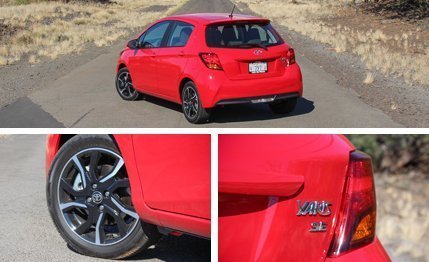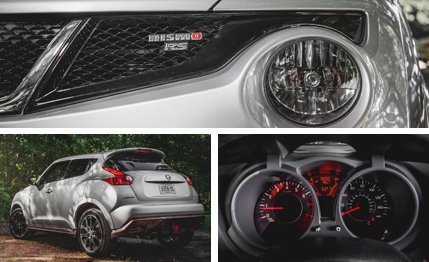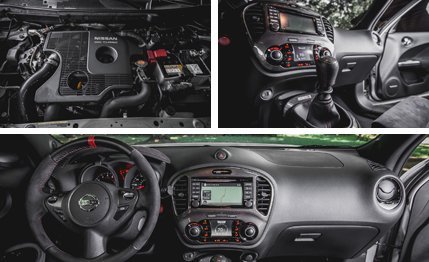
 Instrumented Test
Instrumented Test
On this planet since 2010, the Nissan Juke is the poster child for nonconformist new-wave crossovers. The design looks strangely amphibian, or like something you might encounter while scuba diving a deep reef near the Bahamas. Or a thing to be served with drawn butter and a nice side salad. Polarizing, maybe, but guaranteed to attract attention.
Having successfully defied convention, Nissan’s challenge becomes one of extending the Juke’s appeal—without diluting it. To that end, the company will be making some rather cautious tweaks to the exterior for the 2015 model. But the real appeal-enhancing formula is much simpler and much more traditional: make it go faster.
As with other carmakers, Nissan has a department—NISMO (for Nissan Motorsports, now in its 30th year)—devoted to just that purpose. Last year the mainstream Nissan product planners handed over the Juke to the NISMO irregulars, with a simple mandate: Pick up the pace. When NISMO was finished, not one but two Jukes rolled out of the shops: the Juke NISMO and the Juke NISMO RS. (There is also the very-limited-edition, GT-R–powered Juke-R, but that is of another earth.)
The basic distinguishing characteristic of the NISMO editions is increased output from the 1.6-liter four-cylinder turbo. The regular Juke generates 188 horsepower and 177 lb-ft of torque, output sufficient to tow a 2011 Juke SL we tested to 60 mph in 7.5 seconds and through the quarter-mile in 15.7 at 91 mph. Those certainly aren’t face-distorting numbers, but the car’s acceleration was enhanced by lively dynamics that we characterized, accurately, as “fun.” And as you’d hope, that characterization acquires a capital F in the RS.


The output of the NISMO 1.6-liter varies from NISMO to NISMO RS, and in the case of the RS, according to whether the Juke is packing front- or all-wheel drive. In the Juke NISMO, both front- and all-wheel-drive versions are rated at 197 horses and 184 lb-ft. NISMO RS models with AWD pack 211 horsepower and 184 lb-ft, while the front-drive RS steams along with 215 ponies and 210 lb-ft of twist.
For the RS, the limiting factor is transmission choice. Opting for AWD restricts the owner to the Xtronic continuously variable automatic, which has torque-capacity limitations. Front-drive models come exclusively with a six-speed manual that can handle more muscle. The manual gearbox in our NISMO RS test car suffered from a scratchy 1-2 shift, but once past that, it was exceptionally crisp and precise, allowing us to quickly snick through the gears.
Extracting extra power for the RS entails the use of a freer-flowing exhaust system, tweaks to the ECU, and heftier connecting rods. The NISMO techs have also revised the RS manual transmission’s internal gearing and chosen a slightly shorter final-drive ratio. What all this adds up to is zero-to-60 in 6.7 seconds and the quarter-mile in 15.2 at 95, with a top speed of 135 mph—not bad for a vehicle with the aerodynamic profile of a croaker.
Higher output usually equals lower mpg. But that’s not the case here. Equipped with a six-speed manual transmission, the basic Juke, Juke NISMO, and Juke NISMO RS all receive 25-mpg city and 31-mpg highway EPA ratings. We averaged 22 mpg in enthusiastic driving.


So, NISMO makes a quicker Juke. But equally entertaining, maybe even more so, is the car’s agility. We praised the reflexes of the standard Juke when it made its debut, and the NISMO massage raises the dynamic ante. Suspension components are firmer in the Juke NISMO, firmer still in the RS, augmented by selective chassis stiffening, a substantial footprint, and sticky performance rubber (225/45-18 Continental ContiSport Contact 5).
The combination of front-wheel drive, a forward weight bias (in this case, 61.5 percent of the car’s mass lies over the front wheels), and a limited-slip diff is a prescription for understeer, which our test track crew listed as “massive.” Nevertheless, the RS pulled an impressive 0.88 g on the skidpad. The car’s body motions are modest for a tallish vehicle, the electrically boosted power steering is quick and precise, and the stiffly bolstered Recaro seats keep front passengers anchored when the g-loads start coming from odd angles. Braking is another strong suit. The NISMO RS brake package is bigger than the regular NISMO’s, and braking performance—161 feet from 70 mph, fade free—is worthy of a sports car.
More performance adds up at the bottom line. No surprise there. Juke pricing starts with the basic front-drive S at $19,980, with the better-equipped SV checking in at $21,800. The base price for the Juke NISMO is $23,890, and the RS starts at $26,930. Our test unit included a $1200 navigation package plus $215 NISMO floor mats for a grand total of $28,345.
That’s enough to bolt you into a new Volkswagen GTI or Ford Focus ST. Both are quicker than this quirky Nissan. But neither aforementioned hot hatch is as likely to get you noticed—especially when you show up at the autocross—on this planet, at least.